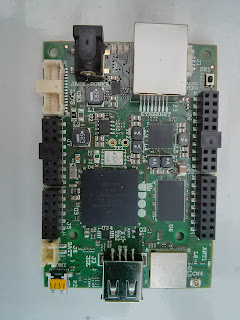 A few weeks back I received an early hardware prototype of the UDOO NEO. It hosts one of the newer members of the i.mx6 family, the i.MX 6SoloX which integrates a Cortex A9 with a Cortex M4. This seems to be Freescales first venture with a heterogeneous SOC, interestingly there may more down the road with the introduction of the i.mx7 (Cortex A7 + Cortex M0/M4).
A few weeks back I received an early hardware prototype of the UDOO NEO. It hosts one of the newer members of the i.mx6 family, the i.MX 6SoloX which integrates a Cortex A9 with a Cortex M4. This seems to be Freescales first venture with a heterogeneous SOC, interestingly there may more down the road with the introduction of the i.mx7 (Cortex A7 + Cortex M0/M4).What is striking about the i.mx6sx architecture is that the primary processor is the Cortex A9. Therefore to boot the i.mx6sx requires uboot or (another i.mx6 bootloader) to be present. Once the A9 is active the secondary processor (Cortex M4) can be brought on-line, either through uboot or after the A9 starts running Linux. In either case, application code (and/or bootloader) has to be made available to the M4 via on board flash or loaded into RAM. The M4 is brought on-line via a Reset following the standard Cortex M4 start up process of booting from a vector table at address zero (which in the A9 world is mapped to 0x007f8000). From what I understand address zero seems to be 32K of TCM (Tightly-coupled memory). The M4 seems to be capable of interacting with most of the on-board peripherals provided by the i.mx6sx. Other areas of interests on the i.mx6sx are :
- An semaphore mechanism (SMEA4) to aid processor contention
- A messaging mechanism (MU) to enable the two processors to communicate and coordinate by passing messages
What is unusual is the inclusion of the video analogue to digital converter (PAL/NTSC). Given that Freescale target market is Automotive I suspect this is for applications like reverse parking.
In it's current form the NEO has a small footprint (850mm x 600mm) and the notable on board peripherals are:
- Ethernet (10/100) - KSZ8091RNA
- Wifi/bluetooth - WL1831MOD
- HDMI - TDA19988
- Gyroscope - FXAS21002C
- Accelerometer + Magnetometer - FXOS8700CQ
- 2 User defined LED's
- 1 USB 2.0 type A female connector
Having started to develop code for the TDA19988 interface, one useful feature of this controller is the ability to support DVI or HDMI displays. The downside being that the GPU struggles past 720p in my tests.
Another point to note is that there is no on board flash for the M4. Therefore code for the M4 has to be loaded into RAM which means reserving a small portion away from kernel. This introduces another layer of complexity as the reserved area needs to be protected from accidental access.
Developing for the board definitely gives you a good insight in its usability. This leads to my wish list, if the board were to be improved :
1. 2 x USB 2.0 type A connectors, for keyboard & mouse useful when used with HDMI.
2. 2 x Ethernet (definitely make it stand out from the competing SBCs).
3. Use SPI for FXAS21002C & FXOS8700CQ or ideally replace with 9 axis IMU.
4. I'd prefer the sensors to be on a separate pcb that can be connected via a jump cable to the main board. The main reason being that manoeuvring the board to test the sensors with the cables attached (ethernet, serial, power, usb, hdmi) isn't that practical.
5. On board JTAG support, it is very difficult to debug the M4 code without it!
6. There are two uart outputs, one for A9 serial console and other for the M4 on the NEO. Similar to the UDOO it would be very useful if these were exposed via single usb connector. In the current design you need to hook up 2 serial-to-usb adapters.


































